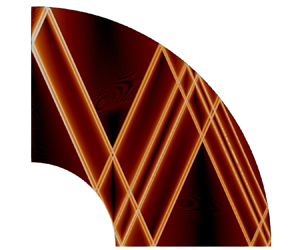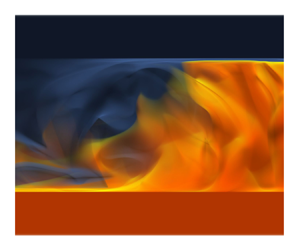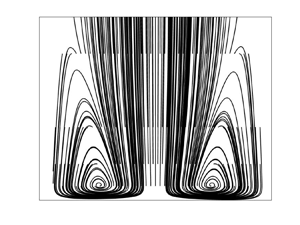Most cited
This page lists all time most cited articles for this title. Please use the publication date filters on the left if you would like to restrict this list to recently published content, for example to articles published in the last three years. The number of times each article was cited is displayed to the right of its title and can be clicked to access a list of all titles this article has been cited by.
- Cited by 6
Dynamics of a two-layer flow with an interfacial heat source/sink: viscosity stratification
-
- Published online by Cambridge University Press:
- 21 January 2022, A43
-
- Article
-
- You have access
- Open access
- HTML
- Export citation
- Cited by 6
Internal shear layers in librating spherical shells: the case of attractors
-
- Published online by Cambridge University Press:
- 23 October 2023, A3
-
- Article
- Export citation
- Cited by 6
Realizing the ultimate scaling in convection turbulence by spatially decoupling the thermal and viscous boundary layers
-
- Published online by Cambridge University Press:
- 25 May 2021, R3
-
- Article
- Export citation
- Cited by 6
Vapour-bubble nucleation and dynamics in turbulent Rayleigh–Bénard convection
-
- Published online by Cambridge University Press:
- 13 April 2016, pp. 60-95
-
- Article
- Export citation
- Cited by 6
Three-dimensional shock wave reflection transition in steady flow
-
- Published online by Cambridge University Press:
- 06 November 2018, pp. 565-587
-
- Article
- Export citation
- Cited by 6
Two-dimensional partially ionized magnetohydrodynamic turbulence
-
- Published online by Cambridge University Press:
- 11 August 2020, A28
-
- Article
- Export citation
- Cited by 6
The impact of finite span and wing-tip vortices on a turbulent NACA0012 wing
-
- Published online by Cambridge University Press:
- 22 October 2024, A68
-
- Article
-
- You have access
- Open access
- HTML
- Export citation
- Cited by 6
Kazantsev model in non-helical 2.5-dimensional flows
-
- Published online by Cambridge University Press:
- 13 October 2016, pp. 627-648
-
- Article
- Export citation
- Cited by 6
Lorentz force effects in the Bullard–von Kármán dynamo: saturation, energy balance and subcriticality
-
- Published online by Cambridge University Press:
- 26 June 2015, pp. 501-523
-
- Article
- Export citation
- Cited by 6
The influence of wall roughness on bubble drag reduction in Taylor–Couette turbulence
-
- Published online by Cambridge University Press:
- 20 July 2018, pp. 436-446
-
- Article
-
- You have access
- Open access
- HTML
- Export citation
- Cited by 6
Compound viscous thread with electrostatic and electrokinetic effects
-
- Published online by Cambridge University Press:
- 30 April 2012, pp. 171-200
-
- Article
- Export citation
- Cited by 6
Stokes flow for a shrinking pore
-
- Published online by Cambridge University Press:
- 23 December 2015, pp. 228-245
-
- Article
- Export citation
- Cited by 6
Two-dimensionally stable self-organisation arises in simple schooling swimmers through hydrodynamic interactions
-
- Published online by Cambridge University Press:
- 02 December 2024, A90
-
- Article
-
- You have access
- Open access
- HTML
- Export citation
- Cited by 6
Jet mixing enhancement with Bayesian optimization, deep learning and persistent data topology
-
- Published online by Cambridge University Press:
- 20 August 2024, A5
-
- Article
- Export citation
- Cited by 6
Pattern imaging of primary and secondary electrohydrodynamic instabilities
-
- Published online by Cambridge University Press:
- 08 February 2006, pp. 61-69
-
- Article
- Export citation
- Cited by 6
Propagation and stability of vorticity–entropy waves in a non-uniform flow
-
- Published online by Cambridge University Press:
- 07 March 2007, pp. 149-176
-
- Article
- Export citation
- Cited by 6
Self-limiting and regenerative dynamics of perturbation growth on a vortex column
-
- Published online by Cambridge University Press:
- 08 February 2013, pp. 39-88
-
- Article
- Export citation
- Cited by 6
The effect of inertia and vertical confinement on the flow past a circular cylinder in a Hele-Shaw configuration
-
- Published online by Cambridge University Press:
- 11 January 2022, A8
-
- Article
-
- You have access
- Open access
- HTML
- Export citation
- Cited by 6
A numerical study on the oscillatory dynamics of tip vortex cavitation
-
- Published online by Cambridge University Press:
- 25 October 2024, A13
-
- Article
- Export citation
- Cited by 6
An inviscid modal interpretation of the ‘lift-up’ effect
-
- Published online by Cambridge University Press:
- 19 September 2014, pp. 82-113
-
- Article
- Export citation





























































































